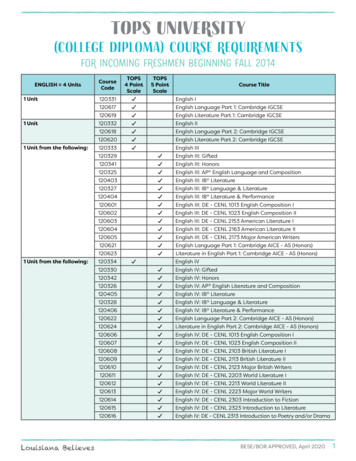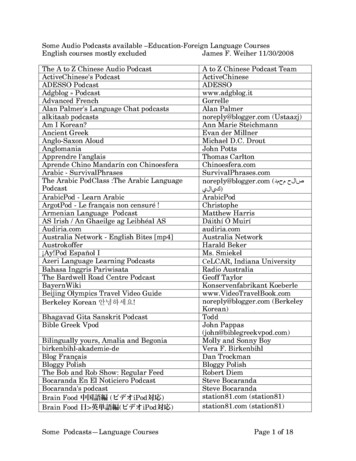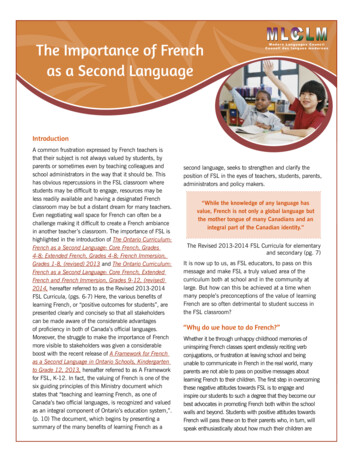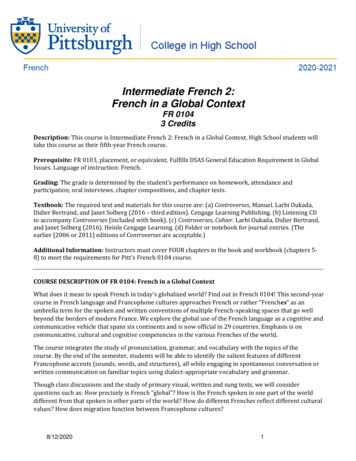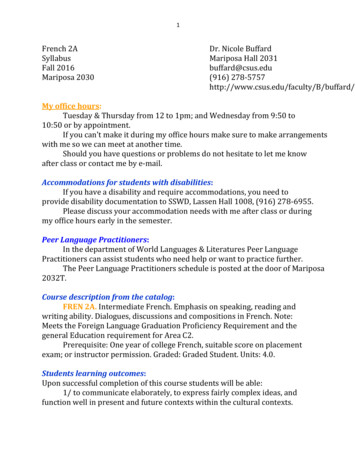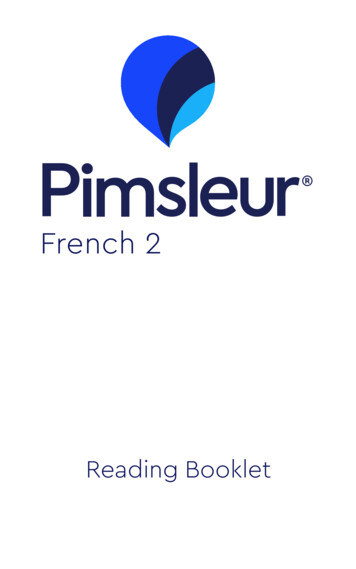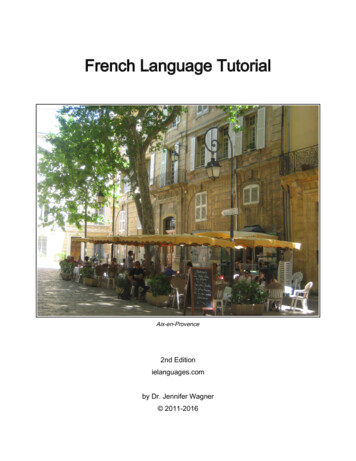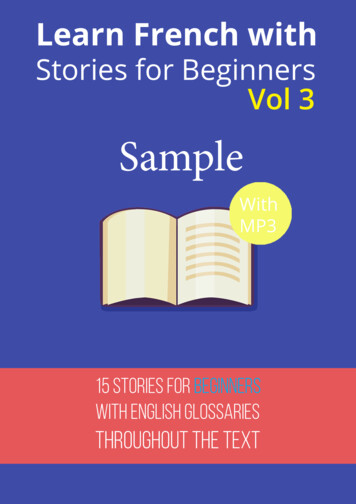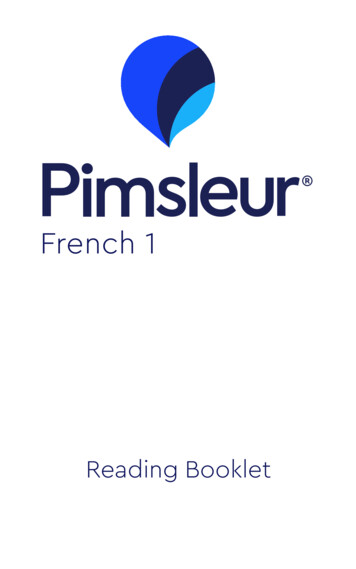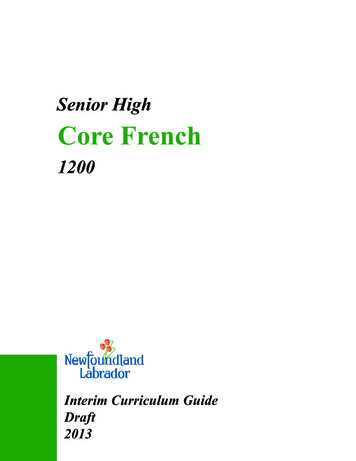
Transcription
Senior HighCore French1200Interim Curriculum GuideDraft2013
ACKNOWLEDGMENTSAcknowledgmentsThe Department of Education acknowledges the teachers and theprogram specialists who contributed their time, ideas and suggestionsduring the development of Core French 1200.The Department of Education acknowledges the significant contributionof Dr. Claude Germain and Dr. Joan Netten in developing the HighSchool Core French curriculum for Newfoundland and Labrador. InChapter 2, they outline the current principles and teaching strategies forthe Neurolinguistic Approach. Their expertise with this approach, andwith second language learning, has been instrumental in the renewal ofCore French programming in Newfoundland and Labrador.Claude Germain, formerly a full professor, now retired from theUniversity of Quebec in Montreal, has a wide experience in the field ofteaching and learning of second languages. He has published severalbooks and articles on language teaching, and has given conferencesinternationally. With Joan Netten, he has conceived a new way to teachsecond languages, the Neurolinguistic Approach, and has been activelyinvolved in implementing the program, known as Intensive French, inall the provinces and territories of Canada. This approach is also beingused to develop new programs for other second languages, includingaboriginal languages.Joan Netten, Honorary Research Professor, Faculty of Education,Memorial University, has been involved in teaching and research forFrench as both a first and a second language. She is the author of anumber of articles on language teaching, particularly for immersion, andhas served on several governmental committees to improve the teachingof French in Canada. With Claude Germain, she has conceptualisedthe Neurolinguistic Approach and introduced Intensive French, firstof all in Newfoundland and Labrador and subsequently in the rest ofCanada. She has received the Order of Canada for her contribution tothe advancement of linguistic duality in Canada.CORE FRENCH 1200 (DRAFT) CURRICULUM GUIDEi
iiCORE FRENCH 1200 ((DRAFT) CURRICULUM GUIDE
TABLE OF CONTENTSTable ofcontentsAcknowledgements.iChapter 1 - Introduction Chapter 2- Learning andTeaching in Core FrenchFundamental Principles.7Literacy Based Approach .11Teaching Approach for Oral Production.13Teaching Strategies for Reading.19Teaching Strategies for Writing. .32Strategies to Help Literacy Development .43Chapter 3 - CurriculumOutcomesGeneral Curriculum Outcomes .45Oral Production .47Oral Interaction .51Reading and Viewing .57Writing and Representing .65Appreciation of French Langauge and Cultural Diversity .75Chapter 4 - Assessment &EvaluationAppendix ARationale . 1Outcomes Framework .2An Outcomes Oriented Approach .3Essential Graduation Learnings .4Program Content .6Assessment & Evaluation. 83Using Rubrics . 87Appendices.89Appendix A.91Appendix B.109Appendix C.151Appendix D.177Appendix E.191Appendix F.195CORE FRENCH 1200 (DRAFT) CURRICULUM GUIDEiii
ivCORE FRENCH 1200 ((DRAFT) CURRICULUM GUIDE
CHAPTER 1 - INTRODUCTIONRationaleBeing able to communicate in both French and English, Canada’sofficial languages, is desirable for all students in Newfoundland andLabrador. Learning French as a second language and learning aboutFrancophones promote an awareness of linguistic and culturaldiversity. This helps foster an openness toward others, essential forfull participation in today’s bilingual, multicultural Canada and inthe larger global, multilingual community. In Canada and elsewhere,the ability to communicate in a second language is an asset in findingemployment. Most importantly, the study of a second language is anenriching educational experience, long recognized for itscontributions to the social, emotional and intellectual development oflearners. It fosters the development of problem-solving and creativity,and it prepares students for opportunities to learn a third or fourthlanguage. Throughout the world, second language education isoffered as part of a regular school program.In Newfoundland and Labrador, the majority of students study French asa second language through the Core French program. In a Core Frenchprogram, students learn French during a regularly scheduled time slot inthe school day. In this province, the Core French program is organizedsequentially in three stages: elementary (grades 4, 5 and 6), intermediate(grades 7, 8 and 9) and senior core high (French 1200, 2200 and 3200,3201). Other Program options in Core French include Primary CoreFrench (grades k-3), intensive Core French (Grade 6), and ExpandedCore French (Senior High).The Department of Education has identified a set of essentialgraduation learnings for all students graduating from high school.These learnings describe the knowledge, skills and values whichprepare students for lifelong learning. The Senior Core Frenchprogram reflects Essential Graduation Learnings.In addition to information on an outcomes-oriented approach, thisdocument provides guidance on instruction, evaluation and resources.The resources, both suggested and recommended, and the authorizedstrategies for instruction and assessment, help teachers plan effectivelearning experiences for students.CORE FRENCH 1200 (DRAFT) CURRICULUM GUIDE1
CHAPTER 1 - INTRODUCTIONOutcomes FrameworkThe curriculum for Core French 1200 addresses the common essential graduation learnings as well as general curriculum outcomes.The conceptual map shown below provides the blueprint of the outcomesframework.Essential Graduation Learningsaesthetic expressioncitizenshipcommunicationpersonal developmentproblem solvingtechnological competenceGeneral Curriculum OutcomesStatements that identify what students are expected to knowand be able to do upon completion of study in a subject areaKey-stage Curriculum OutcomesStatements that identify what students are expected to knowand be able to do by the end of grades 3, 6, 9, and 12Specific Curriculum OutcomesStatements that identify what students are expected to knowand be able to do at a particular grade level2CORE FRENCH 1200 (DRAFT) CURRICULUM GUIDE
CHAPTER 1 - INTRODUCTIONAn OutcomesOriented ApproachAn Outcomes-Oriented ApproachEssential Graduation Learnings provide the framework for curriculumoutcomes. Curriculum outcomes articulate what students are expectedto know, value and be able to do. General curriculum outcomeslink subject areas to the essential graduation learnings and providean overview of the expectations of student performance. Key stageoutcomes identify what is expected of students at the end of a level ofschooling. Specific curriculum outcomes set out what is expected ofstudents by the end of a grade or course.Curriculum outcomes inform teachers, parents and students.Outcomes guide educators in selecting resources and instructionalstrategies and they provide a framework to monitor student progressand achievement.Outcomes and Language LearningLanguage learning is a cumulative process; thus, outcomes overlap fromtheme to theme, unit to unit and year to year. From grade to grade,language notions and patterns become more complex. The progressionin language learning is communicated by the depth of treatment,the level of difficulty, and by the nature of the task. Concepts andoutcomes introduced at the elementary level are further developed inthe intermediate and high school years.CORE FRENCH 1200 (DRAFT) CURRICULUM GUIDE3
CHAPTER 1 - INTRODUCTIONEssential GraduationLearnings and CoreFrenchThe Essential Graduation Learnings describe the knowledge, skills andvalues expected of all students who graduate from the school systemof Newfoundland and Labrador. The Essential Graduation Learningsprovide the framework for the development of prescribed schoolprograms.Aesthetic ExpressionGraduates will be able to respond with critical awareness to variousforms of the arts and be able to express themselves through the arts.Aesthetic expression encourages learning in and about the arts andhighlights the contribution of the arts to society. Core French learnersuse various art forms to express their ideas and feelings. Drawing,music, short plays are included in the Core French.CitizenshipGraduates will be able to assess social, cultural, economic andenvironmental interdependence in a local and global context.Language and culture are linked to citizenship. The Senior high CoreFrench program promotes recognition of the multicultural nature ofour country and encourages learners to develop respect for others.Learning French and learning about Francophones help students gaina better understanding of Canada’s bilingual identity. In Senior HighCore French, students develop an understanding of the links betweenlanguage, culture, and identity.CommunicationGraduates will be able to use the listening, viewing, speaking, readingand writing strands of language(s), and other ways of representing,as well as mathematical and scientific concepts and symbols to think,learn, and communicate effectively.Communication is the main focus of the Core French program.Students classes explore, express and reflect on ideas, knowledge,perceptions and feelings.Core French students use all modes of language to explore topics ofinterest. As well, focus on language learning strategies enables studentsto strengthen their overall communication skills.4CORE FRENCH 1200 (DRAFT) CURRICULUM GUIDE
CHAPTER 1 - INTRODUCTIONPersonal DevelopmentGraduates will be able to continue to learn and pursue an active,healthy lifestyle.Learning a language is a social activity which develops personal andinterpersonal skills. The Senior High Core French program promotesresponsible decision-making, healthy lifestyles, intellectual curiosity andrisk-taking. The program encourages students to view second languagelearning as a life skill.Problem SolvingGraduates will be able to use the strategies and processes needed tosolve a variety of problems, including those requiring language, andmathematical and scientific concepts.Problem solving is the basis of second language learning. In the SeniorHigh Core French program, students use strategies and processes toaccess information, to clarify and negotiate meaning, to give opinionsand to cope effectively in unfamiliar situations. Working alone and withothers, students apply critical, analytical and creative thinking skills tocommunicate in different ways in a variety of situations.Technological CompetenceGraduates will be able to use a variety of technologies, demonstratean understanding of technological applications, and apply appropriatetechnologies for solving problems.Technological competence is an essential element of schooling. In CoreFrench students and teachers use many different technologies. Facilityin using the Internet, Smart technologies, processing and presentationsoftware demonstrate technological competence.Spiritual and Moral DevelopmentGraduates will demonstrate understanding and appreciation for theplace of belief systems in shaping the development of moral values andethical conduct.In the Senior High Core French program, students explore othercultures. They come to appreciate the traditions and values of others, aswell as those of their own cultural community. Students identify waysin which they are similar to, and different from, Francophones. Theyalso recognize the benefits of living in a bilingual, multicultural country.CORE FRENCH 1200 (DRAFT) CURRICULUM GUIDE5
CHAPTER 1 - INTRODUCTIONProgram ContentAdolescent Life Family, friendsPhysical descriptionCharacter traitsInterests and hobbiesDaily routine and activitiesFashionSchool lifeVolunteeringChallenges and SolutionsMy Future Part time JobsCareersEnvironmentTechnologyTravel Travel and experiencesInterestsVacation activities and destinationsTravel essentialsMethods of travelWeatherTravel AwarenessThe World Around MeCultural activities, events and traditionsFoodMusic and the artsContributions of individuals6CORE FRENCH 1200 (DRAFT) CURRICULUM GUIDE
CHAPTER 2 - LEARNING AND TEACHING IN CORE FRENCHFUNDAMENTAL PRINCIPLES.Second language learning is associated with the communication of ideas, opinions, emotions and withthe understanding of a different world view; learning French as a second language provides an enrichingeducational and literacy experience. The High School Core French program is based on the followingprinciples. These principles form the foundation for teaching and learning activities.1. AUTHENTICITY: Learning to communicate in a Second language (L2) requires the use of thislanguage in authentic communication situations.In the Second language classroom, authentic communication starts immediately. For communication to beauthentic, students must be able to express what they wish to say and share views with other students. This isan extension of what the students are already able to do in their first language (L1.), though it may be morelimited.Students use the language in authentic situations. Teaching French should be “déscolarisé” as much aspossible. It would be inappropriate to have all students repeat sentences such as Mme N. est une personneimportante dans ma vie parce que., when this fact may not be true and authentic. Repeating or memorizingfacts that have no authenticity for students may lead to lack of motivation for learning the language. However,a sentence such as Mme N. est une personne importante dans la vie de. [name of a student ], can berepeated, as long as it is authentic.Authentic conversation should consist of more than a question and an answer without follow-up. Above all,emphasis is on the message while still focussing on accuracy of the language. Teachers should engage studentsin a discussion with a natural comment or question that follows their own response. For example, if a studenttalks about what he had for breakfast, the teacher can ask if it tasted good or ask whether other students atethe same thing (instead of simply replying “Très bien”). In order to respect this principle, teachers should stayaway from teaching only ONE question at a time, followed by an answer.When students have some difficulty providing their own answers to a question, the teacher must present alanguage model and ask students to use this model by modifying it to fit their own situation. For example, inthe event that a student forgets the French for. because he taught me how to play hockey, the teacher shouldnot whisper the answer so the student can repeat it; the teacher must instead refer back to a sentence modelledafter a similar personal situation (e.g. Mme N. m’a enseigné à faire la cuisine) and ask the student to answerthe question by modifying the model to fit his own situation (e.g. Mon cousin m’a enseigné à jouer auhockey).Using the language in authentic communication situations lead, to the development of spontaneousoral and written communication abilities.CORE FRENCH 1200 (DRAFT) CURRICULUM GUIDE7
CHAPTER 2 - LEARNING AND TEACHING IN CORE FRENCH2. LITERACY: The learning of a language for the purposes of communication consists of developingliteracy skills.In French second language programs (FSL), emphasis is mainly on the development of literacy skills. In FSLprograms, as is the case for literacy in L1, oral comprehension and production must be developed as well asreading and writing.In learning an L2, the oral component should be taught before everything else. Usually, learners cannot read orwrite without first acquiring the ability to talk with a certain degree of spontaneity about the topic introducedin the reading. The notion of L1 literacy must therefore be adapted to a particular L2 context. It should notbe assumed that the student already has the ability to converse on the topic. L2 teaching must always start offwith the oral language before engaging in reading or writing activities. In the initial stages of learning howto read, reading consists of recognizing the words in print as a representation of the previously acquired orallanguage. The same is true for writing skills. Oral, reading and writing skills are linked in the following way:oral skills link to reading, and reading skills link to writing skills. The cycle is completed with a discussion ofwritten texts after they have been read.3. COGNITIVE DEVELOPMENT: A project-centred approach facilitates engagement in cognitiveand language demanding tasks.As Paradis (2004, 2009) points out in his neurolinguistic theory of bilingualism, the only way to learn to usea language is to concentrate on the message rather than the language forms. The emphasis should thereforebe placed on activities related to projects. This will allow students to subconsciously internalize the languagestructures, since they will be focussed on their task or project. Without developing this implicit competence,students are incapable of using the language spontaneously. As Paradis (2004, 2009) points out in hisneurolinguistic theory of bilingualism, the only way to learn to use a language is to concentrate on the messagerather than the language forms. The emphasis should therefore be placed on activities related to projects. Thiswill allow students to subconsciously internalize the language structures, since they will be focussed on theirtask or project. Without developing this implicit competence, students are incapable of using the languagespontaneously.L2 learning does not consist of a series of unrelated activities. The project-based approach focuses specificallyon setting a common objective for all activities of a unit in which the students are engaged. Activities mustbe sequenced to ensure students cognitive and linguistic development. Certain activities prepare students forothers. It is preferable to limit the number of structures and sentences introduced to students. Teachers ensurethat those structures modelled are used and reused by students, adapted to their own circumstances and reusedin different situations. A project-based pedagogy provides a variety of situations in which the language formsmay be used.Students are asked to perform tasks that are cognitively and linguistically demanding. These tasks contributeto the general cognitive development of students as well as the development of their language skills. Studentinvolvement in cognitively demanding tasks encourages students to use the second language implicitly.4. INTERACTION: Interactive teaching strategies contribute to the improvement of linguisticcommunication and the cognitive development of students.Cognitive development is not only enhanced by the type of activities the students engage in, but also byinteraction (Vygotsky, 1986). Contrary to Piaget‘s theory, which states that social and cognitive developmentoccur simultaneously yet are not linked to each other, recent research shows that social interaction contributesto an individual‘s cognitive development (Doise & Mugny, 1981; Perret-Clermont, 1980; SchubauerLeoni, 1989). Interaction enables students to communicate in L2 and also enhances their general cognitivedevelopment.8CORE FRENCH 1200 ((DRAFT) CURRICULUM GUIDE
CHAPTER 2 - LEARNING AND TEACHING IN CORE FRENCHInteraction allows for the reuse of language. It is through the use and reuse of language in authenticsituations that students can develop a certain degree of spontaneity in the language being learned through thedevelopment of an internal grammar. Therefore, students must spend considerably more time talking than theteacher. Unlike authentic conversations, a memorized dialogue is not a form of natural interaction.It does notinvolve logic and emotions, or the ability to react to an unexpected response. In a memorized dialogue, thestudents already know in advance the response of their partner. This is not the case in authentic interaction.The students should interact with spontaneity in authentic communication.5. IMPLICIT COMPETENCE: The learning of an L2 for the purposes of communication requiresautomation (or proceduralization) of language structures.The ability to communicate spontaneously in a second language relies on the development of an implicitcompetence or internal grammar. In order to develop an internal grammar the students must use and re-usethe language structures in oral production and in a wide variety of situationThis is why, for teaching oral production, we do not begin by teaching explicit knowledge but rather bydeveloping an implicit competence. According to recent neurological research explicit knowledge cannot betransformed into a skill; that which is conscious knowledge cannot become subconscious. Thus, learninglanguage forms and structures as declarative knowledge is of little use to L2 learners in communicatingin French, since the development of oral communication skills means being able to use the languageautomatically or subconsciously to express a message. Explicit knowledge of language forms and structuresis useless in authentic conversations and is stored in a part of the brain that is completely separate from thatwhich stores skills. According to certain researchers, there is no direct link between these two parts of thebrain (Paradis 2004, 2009), but only an indirect link in the direction of the explicit knowledge looking atthe implicit competence already used (e.g. monitoring oral production). In an authentic conversation, it istherefore impossible to access explicit knowledge of the language quickly enough to use it to monitor oralcompetence, and communicate spontaneously and easily. This is why it is crucial to first focus on acquiringskills (implicit competence or internal grammar) before acquiring knowledge by having students use thelanguage in the form of a conversation right from the start. As is the case for L1, it is only through readingand writing that one can gain, and use, an explicit knowledge of a language.Accuracy and fluency in a language are necessary for proper communication in an L2. Accuracy and fluencyin oral language are both skills. In FSL programs, fluency is developed by emphasizing the use of completesentences in authentic communication situations in such a way as to allow the students to subconsciouslymake the necessary links—in terms of phonology, morphology, syntax and discourse—to build an internalgrammar. Internal grammar consists of patterns (or neural networks) in the brain appearing in the form of animplicit competence or skill that allows students to use the language without paying conscious attention to theforms involved. Internal grammar is not the type of grammar made of memorized rules. Implicit competencedoes not consist of the transformation of explicit knowledge (e.g., in the form of rules) through "exercises". Inother words, knowledge (explicit) cannot be transformed into a skill (implicit) through a set of exercises. Thetwo are separate and distinct aspects of language learning that must be developed by separate types of activities(Paradis 2004, 2009).CORE FRENCH 1200 (DRAFT) CURRICULUM GUIDE9
CHAPTER 2 - LEARNING AND TEACHING IN CORE FRENCHFSL programs require a sentence-based pedagogy. The focus is on learning sentences rather than on learningvocabulary words requiring a well-known structure. For every new structure students use a complete sentenceuntil the structure in question is internalized. Students may sometimes use a few words rather than a completesentence if the response requires a well known structure.This concept stems from the fact that it is difficult for students to build an internal grammar from a verticalpresentation of the language (vocabulary word lists); in order to build an internal grammar, they mustwork on a horizontal plane. In other words, students must use sentences in order to establish subconsciousconnections (or neural links) between the various language components. Without an internal grammar,students are unable to communicate spontaneously in L2Development of oral accuracy as a skill occurs only through the use and reuse of correct language forms inauthentic communication situations. The correction of errors in oral production is therefore essential in FSLprograms (refer to pp.16-17). Otherwise, the students will develop an incorrect internal grammar. Learninggrammatical forms explicitly is useful for the analysis of how a language works, or for monitoring what hasbeen produced spontaneously, but it is not useful for developing the ability to communicate spontaneously inthe second language. While at this level one can begin to explain why one says things in a certain manner, it isstill the use of the correct language form that is more important than the reason why this form is appropriateTeachers should pay particular attention to the simultaneous development of fluency (by having the studentproduce complete sentences) and accuracy (by regularly correcting students’ oral errors) By acquiring animplicit competence that reflects a correct internal grammar, students will be more capable of achieving abalance between fluency and accuracy.10CORE FRENCH 1200 ((DRAFT) CURRICULUM GUIDE
CHAPTER 2 - LEARNING AND TEACHING IN CORE FRENCHLITERACY-BASED APPROACHThe Core French Program is based on a literacy-based learning approach that is similar to that used inlearning a first language (L1), but takes into account aspects that are specific to the learning of a secondlanguage. In other words, the L2 is taught in the same way as the L1 with adaptations for the L2 context. Theemphasis is therefore on authentic communicative situations rather than on language forms, and the languageis used by the students as a means for personally expressing their thoughts. In the perspective of a conceptionof literacy specific to L2, reading closely follows oral production, writing closely follows reading, and allthree language skills are closely linked. This literacy experience encourages students to develop their abilityto use language and images in rich and varied forms to read, write, listen, speak, view, represent, and thinkcritically about ideas[at the relevant levels] in both their first and second languages. This approach also takesinto account individual differences in learning with a dual focus on differentiated instruction and multipleintelligences and allows students to complete more challenging tasks. These factors contribute to greaterdevelopment of both language and cognitive skills.Importance of oral componentEmphasis is placed on developing oral communication. As is the case for all authentic communicativesituations, oral comprehension and production are closely linked (Brumfit, 1984). It is necessary to createan environment where French is the language of communication from day one. Only French is used in theclasroom. In order to create this atmosphere, students and teachers regularly interact in French, and gradually,students start conversing with each other in French. To learn French, students need to speak French, notEnglish. In terms of literacy development, students must be able to talk about their day-to-day life andpersonal experiences with a certain degree of spontaneity. The oral language component must, therefore, begiven considerable importance in the classroom.Importance of the oral component in reading and writingCommunication does not refer uniquely to the oral use of the language. Communication also includesreading and writing skills. Learning to communicate includes the integrated development of oral, reading andwriting through authentic communication situations. Reading and writing are, therefore, taught (withoutassuming an automatic transfer from L1 to L2 of these skills). Therefore, although a topic is introduced orally,reading and writing activities follow almost immediately after. Success in learning to read and write in an L2 isdependent upon an adequate oral foundation (Germain & Netten, 2005). .Literacy in its largest sense consists of an integration of the three strands of language, oral, reading andwriting. It is important to complete the cycle, so to speak, and to ensure that what has bee
Core French programming in Newfoundland and Labrador. Claude Germain, formerly a full professor, now retired from the University of Quebec in Montreal, has a wide experience in the field of teaching and learning of second languages. He has published several books and articles on language teaching, and has given conferences internationally.
